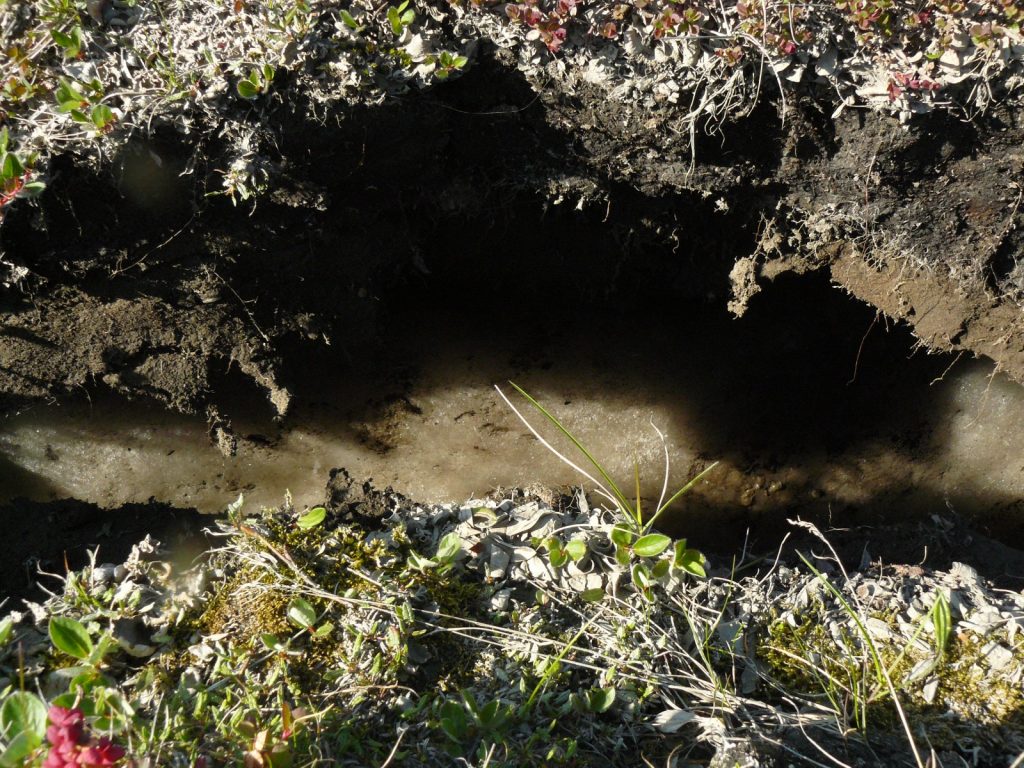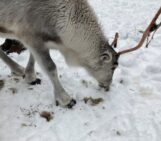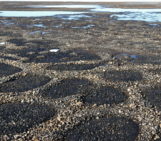
Ice is usually something you see covering large ocean areas, mountain tops and passes or as huge sheets in polar regions. This type of ice is clearly visible from space or with the naked eye. There is, however, a large volume of ice that is less visible. This ice is distributed over the polar and high alpine permafrost regions; and is the ice hidden below ground. It might be hidden, but that doesn’t mean we should ignore it. If this below-ground ice melts, the ground might collapse!
On solid ground?
To change the surface of a landscape usually requires wind or water, which actively erodes the material around it. In permafrost areas, however, different mechanisms are at work. In these areas, the ground or parts of the ground, are frozen all year round and the formation and melting of below-ground ice changes the landscape in a complicated way. Below-ground ice can have many shapes and sizes depending on moisture availability, sediment type and thermal regime (French, 2007). Because a gram of ice has 9 % higher volume than a gram of water, simply freezing, thawing and re-freezing soil water can make the surface “wobbly” and irregular. Since ice doesn’t drain from a saturated soil, as water does, a permanently frozen soil can also contain moisture in excess of the absorption capacity of the soil – excess ice. This means that ice might take up the majority of the ground volume in ice-rich areas.
Our Image of the Week (Fig. 1) was taken in NE Greenland. The phenomenon shown is a result of ground, which has been frozen for many years, being destabilized. In this photo, the below-ground ice has begun to melt, and the decrease in ice volume has caused the ground to collapse, forming what is known as a thermokarst development (Fig. 1). This is just one type of feature that can be caused by below-ground ice mass loss. Kokelj and Jorgenson (2013) give a nice overview of recognized thermokarst features including: retrogressive thaw slumps, thermokarst lakes and active layer detachment slides. Ice melt might also simply be expressed as a lowering of the land surface (thermal subsidence), as observed in peat (Dyke and Slaten, 2010) and in areas with ice wedge polygons (Jorgenson et al., 2006), or in upraised plateaus (Chasmer et al., 2016).
the decrease in ice volume has caused the ground to collapse
The spatial scales of these types of collapse features span from depressions of 10 cm depth to areas of several square kilometers, with thermokarst features many meters deep. The rates of surface change also vary from sudden detachment and slide of the unfrozen upper active layer on slope, to features developed over centuries and even millennia (e.g. Morgenstern et al., 2013).
The most dramatic surface changes often happen where ground ice content is high, such as in the coastal lowland tundras of Siberia (e.g. Morgenstern et al., 2013) or coastal northern Canada (Fortier, et L., 2007). However, thermokarst development is found also in coastal Greenland (Fig. 1) and even the McMurdo Dry Valleys of Antarctica (Levy et al., 2013).
Why does the ground ice melt?
Many factors can lead to the destabilization of below-ground ice bodies. Notable ones are:
- Erosion of the surface allows for atmospheric energy to penetrate deeper into the ground.
- Thermal contraction or other types of cracks might create an easy access to deeper layers for water and energy.
- Persistent running water might erode physically as well as transfer fresh energy into the system.
Fig. 2 shows a recently opened crack in the ground, close to the karst formation shown in Fig.1. The crack reveals a large body of massive (pure ice) below-ground ice. The opening of the crack, however, also creates a highway for heat energy into the now unstable ice body, which will start degrading.

Figure 2: Looking into a recently opened crack revealing a large ice body just below the summer thaw layer, NE Greenland [Credit: Laura Helene Rasmussen]
“And so what?”
The surface changes somewhat. No big deal. Why investigate where and how and how much and how fast?
For people living in permafrost areas thermal subsidence might happen below the foundation of their house or destabilize the one road leading to their local airport (Fortier, et al., 2011).

Figure 3: Taking a closer (!) look at below-ground ice, NE Greenland [Credit: Line Vinther Nielsen].
Thermal subsidence might also change the hydrology of the area, causing surface water to find new routes (Fortier, et al., 2007) or pool in new places. When water pools in the depressions above frozen ground, the exchange of energy between the atmosphere and the permafrost is altered.
There is increased heat transport downward into the ground in summer (Boike et al., 2015), which can then lead to more melting. Similarly, thermokarst development itself exposes more frozen ground to above-zero temperatures, leading to further thawing (Chasmer et al., 2016)
and crucially mobilising otherwise dormant carbon stored in the permafrost (Tarnocai, et al., 2009).
Reports of an increase in rates of thaw have been linked to recent climatic warming (Kokelj and Jorgenson, 2013), and changes in precipitation patterns (e.g. Kokelj et al., 2015). So expect to see this “dirty“ cryospheric component receiving more attention, and don’t be surprised if you see an increasing number of strange scientists figuratively or literally (!) sticking their heads into cracks in the ground…
Edited by Emma Smith and Clara Burgard
 Laura Helene Rasmussen is a Danish permafrost scientist working at the Center for Permafrost, University of Copenhagen. She has spent many seasons in Greenland, working with the Greenland Ecosystem Monitoring Programme and is interested in Arctic soils as an ecosystem component, their climate sensitivity, functioning and simply understanding what goes on below.
Laura Helene Rasmussen is a Danish permafrost scientist working at the Center for Permafrost, University of Copenhagen. She has spent many seasons in Greenland, working with the Greenland Ecosystem Monitoring Programme and is interested in Arctic soils as an ecosystem component, their climate sensitivity, functioning and simply understanding what goes on below.




